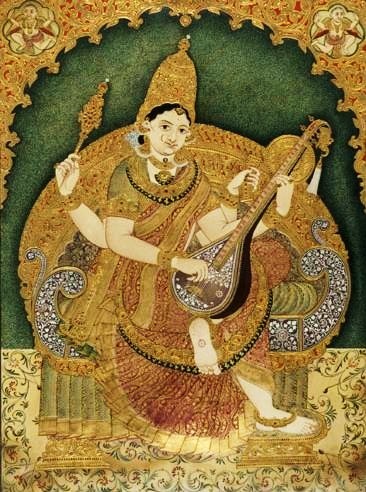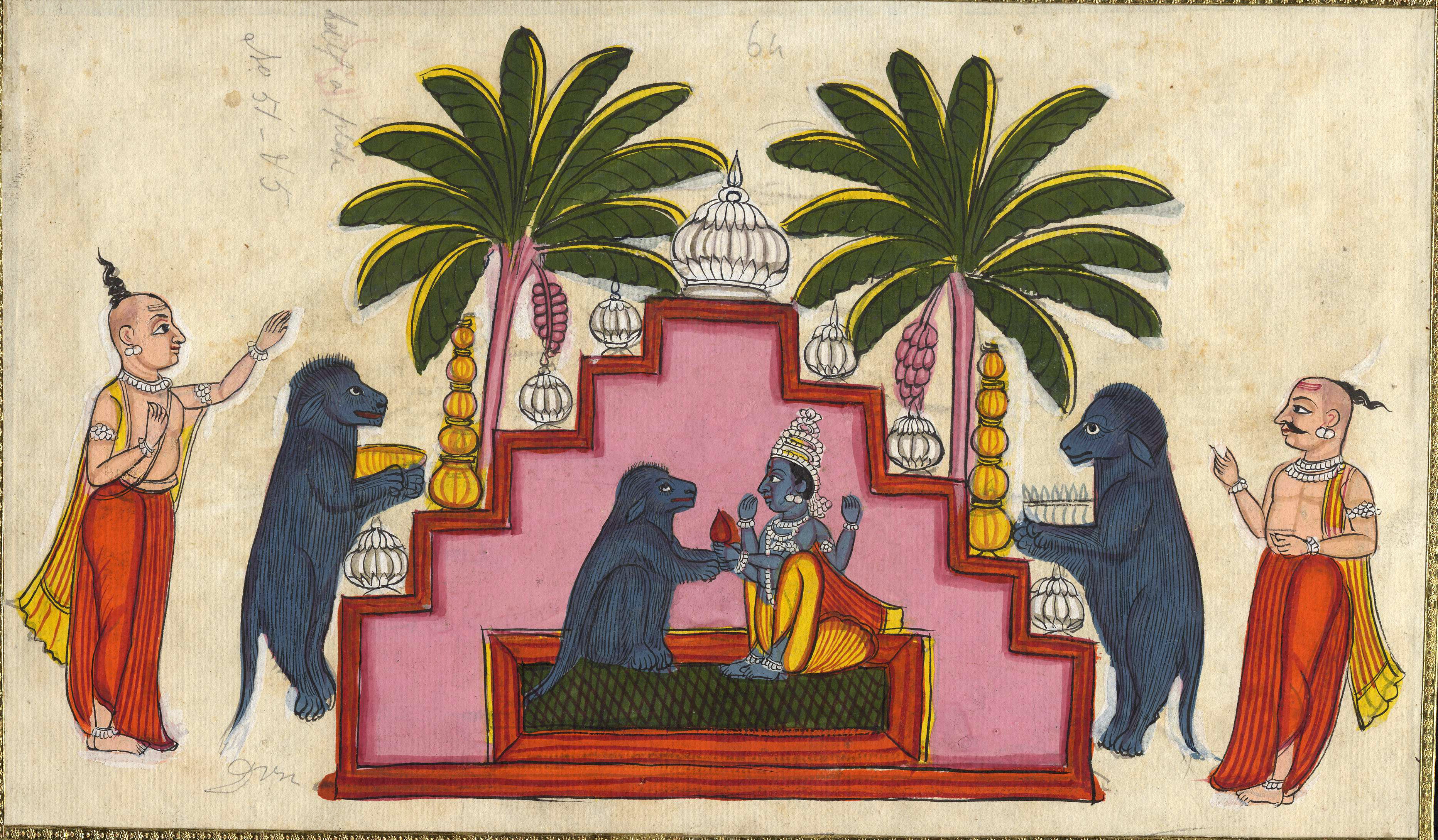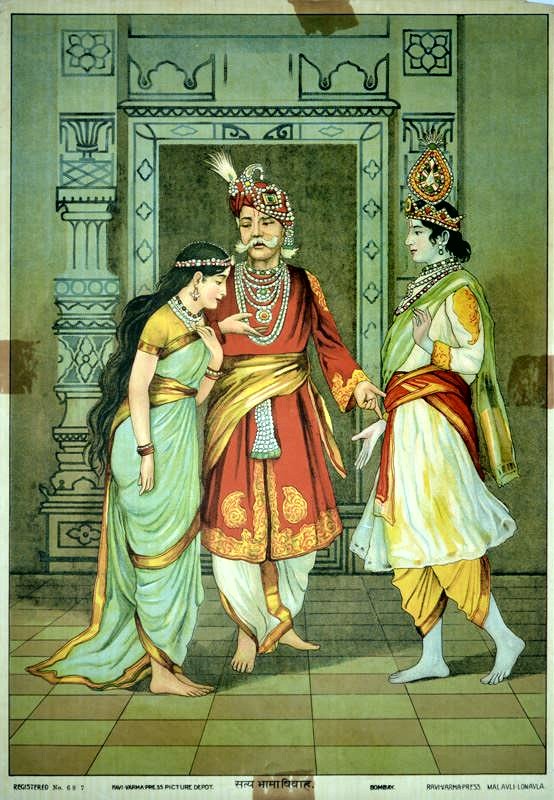|
Ashtabharya
The Ashtabharya or Ashta-bharya(s) is the group of eight principal queen-consorts of Hindu god Krishna, the king of Dvaraka in the Dvapara Yuga (epoch). The most popular list, found in the ''Bhagavata Purana'', includes: Rukmini, Satyabhama, Jambavati, Kalindi, Mitravinda, Nagnajiti, Bhadra, and Lakshmana. Variations exist in the ''Vishnu Purana'' and the '' Harivamsa'', which includes queens called Madri or Rohini, instead of Bhadra. Most of them were princesses. In Hinduism, all of Krishna's consorts including Radha are revered as the avatars of the goddess Lakshmi while the Gopis of Braj are considered as Radha's manifestations. Rukmini, the princess of Vidarbha was Krishna's first wife and chief queen (''Patrani'') of Dvaraka. She is considered as the avatar of Sridevi, the goddess of prosperity. Satyabhama, the third wife, a Yadava princess, is considered as Lakshmi's aspect of the earth-goddess Bhudevi. Jambavati is believed to be the manifestation of the third aspect o ... [...More Info...] [...Related Items...] OR: [Wikipedia] [Google] [Baidu] |
Jambavati
Jambavati () is chronologically the second ''Ashtabharya'' of the Hindu god Krishna. She is the only daughter of the bear-king Jambavan. Krishna marries her when he defeats her father, Jambavan, in his quest to retrieve the stolen Syamantaka jewel. Nomenclature Jambavati, a patronymic, means daughter of Jambavan. Sridhara, a commentator on the ''Bhagavata Purana'', identifies her with Krishna's wife Rohini. However, another commentator Ratnagarbha disagrees. The ''Harivamsa'' also suggests that Rohini may be an alternate name of Jambavati. Jambavati is also given the epithets Narendraputri and Kapindraputra. Legend In the epic ''Mahabharata'', Jambavan is introduced as Jambavati's father. The ''Bhagavata Purana'' and the ''Harivamsa'' calls him the king of bears. Jambavati is an incarnation of the goddess Lakshmi, along with the junior wives of Krishna, as well as the Ashtabharya. Marriage to Krishna The marriage of Jambavati and Satyabhama to Krishna is closely linked w ... [...More Info...] [...Related Items...] OR: [Wikipedia] [Google] [Baidu] |
Mitravinda
Mitravinda () is chronologically the sixth of the ''Ashtabharya'' of the Hindu god Krishna, an avatar of the god Vishnu, and the king of Dvaraka in the Dvapara Yuga (epoch). Etymology Mitravinda was known by the epithet "the virtuous" and called as ''Shaibya'' or ''Shaivya'' (meaning daughter/descendant of King Shibi/Shivi) in the ''Vishnu Purana''. Ratnagarbha, a commentator on the ''Vishnu Purana'', identifies Mitravinda with Kalindi, another chief queen of Krishna. In '' Harivamsa'', she is referred to as Sudatta, the daughter (or patrilineal descendant) of Shibi. Family In the ''Bhagavata Purana'', Mitravinda is described as the daughter of King Jayasena of the kingdom of Avanti. The ''Bhagavata Purana'' describes that she had two brothers Vinda (Vindya) and Anuvinda (Anuvindhya), who ruled Avanti as co-regents at the time of her wedding. They were comrades of Duryodhana, the leader of the Kauravas. They were therefore opposed to the idea of Mitravinda marrying Krishn ... [...More Info...] [...Related Items...] OR: [Wikipedia] [Google] [Baidu] |
Lakshmana (Krishna's Wife)
Lakshmana () or Lakshana is the seventh of the ''Ashtabharya'', the eight principal queen-consorts of Hindu god Krishna, an avatar of the god Vishnu and the king of Dvaraka in the Dvapara Yuga (epoch). Family and names The ''Bhagavata Purana'' mentions Lakshmana, who is endowed with good qualities, as the daughter of an unnamed ruler of the kingdom of Madra. The ''Padma Purana'' specifics the name of the king of Madra as Brihatsena. Lakshmana describes Brihatsena to be a good veena player in a dialogue. Some texts give her the epithet ''Madri'' or ''Madraa'' ("of Madra"). However, the ''Vishnu Purana'' includes Lakshmana in the Ashtabharya list, but mentions another queen Madri, who is explicitly mentioned as the princess of Madra. The lineage of Lakshmana is not alluded to in the text. The text also calls her ''Charuhasini'', one with a lovely smile. The '' Harivamsa'' also calls her Charuhasini, but is not associated with Madra and another queen called Madri or Subhima is m ... [...More Info...] [...Related Items...] OR: [Wikipedia] [Google] [Baidu] |
Bhadra (Krishna's Wife)
Bhadra () is one of the ''Ashtabharya'', the eight principal queen-consorts of Hindu god Krishna, according to the scripture ''Bhagavata Purana.'' The ''Bhagavata Purana'' regards her as being the eighth wife of Krishna; sometimes she is described as the seventh wife. The ''Vishnu Purana'' and the '' Harivamsa'' do not name Bhadra at all in the list of the Ashtabharya, but refer to her as 'the daughter of Dhrishtaketu' or 'the princess of Kekeya'. Legend The ''Bhagavata Purana'' gives her the epithet Kaikeyi, the princess of the Kaikeya kingdom. She was the daughter of King Dhrishtaketu and his wife Shrutakirti, the sister of Kunti and the sister (or cousin) of Vasudeva (Krishna's father) and thus Krishna's cousin. Bhadra's five brothers headed by the eldest prince Santardana married Bhadra to Krishna. In another text, she is described to have chosen Krishna as her husband in a '' Svayamvara'' ceremony, in which a bride chooses a groom from assembled suitors. Krishna and his ... [...More Info...] [...Related Items...] OR: [Wikipedia] [Google] [Baidu] |
Nagnajiti
Nagnajiti (Sanskrit: नाग्नजिती IAST: Nāgnajitī), also known as Satya (Sanskrit: सत्या IAST: Satyā), and Nappinnai (), is the fifth of the ''Ashtabharya'' of the Hindu god Krishna. In Vaishnavite texts, Nagnajiti is said to be an incarnation of Niladevi, the third aspect of Lakshmi. During the Dvapara Yuga, Niladevi was born on the earth as Satya, the daughter of King Nagnajit of Kosala. Krishna competed in the svayamvara arranged by Nagnajit, and as per the set rules, he brought seven ferocious bulls under control by tying a noose around each of them, thus winning Satya as his wife. In South India, when the poet-saint Andal wrote the Thiruppavai and the Nachiyar Thirumoli, she mentions Nappinai, the "beautifully tressed" daughter of King Nagnajita - the brother of Yashoda (foster-mother of Krishna). It is believed that Nappinai is the Tamil equivalent of Nagnajiti. This is attested by the fact Nappinai is also stated to be a form of Vish ... [...More Info...] [...Related Items...] OR: [Wikipedia] [Google] [Baidu] |
Rohini (Krishna's Wife)
Rohini is a queen of the Hindu god Krishna, who is an avatar of the god Vishnu and the king of Dvaraka in the ''Dvapara Yuga'' (epoch). She is mentioned as a queen in the Hindu epic ''Mahabharata'', the ''Vishnu Purana'', the ''Bhagavata Purana,'' and the ''Harivamsa'', an appendix of the ''Mahabharata''. Krishna is described to have the eight principal queen-consorts, the Ashtabharya and 16,000 or 16,100 ceremonial wives; Rohini is described as one of the Ashtabharya or identified with the queen Jambavati in some lists and head of the other wives in a different list. Association with Jambavati The ''Vishnu Purana'' says that Rohini is very beautiful. Ratnagrabha, a commentator on the scripture, includes her as one of the Ashtabharya, identifying her with Jambavati. He considers Rohini as the queen's birth name and Jambavati, a patronymic literally "daughter of Jambavan" her epithet. However, another commentator Sridhara disagrees and considers her as distinct from Jambavati. T ... [...More Info...] [...Related Items...] OR: [Wikipedia] [Google] [Baidu] |
Rukmini
Rukmini ( sa, रुक्मिणी, , ) is a Hindu goddess and the first queen and chief wife of Krishna. In Vaishnava tradition, she is described as Krishna's principal queen in Dvaraka, as well as the chief of his wives. She is an incarnation of the goddess of prosperity, Lakshmi. The goddess is regarded to be the chief or principal consort of Krishna in various pieces of literature and is venerated primarily in Warkari and Haridasa tradition, and additionally in Sri Vaishnavism where Lakshmi-Narayana are revered and worshipped. Rukmini is mainly worshipped in Maharashtra and South India. The people of Maharashtra venerate her with Vithoba (a regional form of Krishna) and call her Rakhumai. In South India, she is worshipped along with Krishna and his other primary consort Satyabhama. Etymology and epithets The name ''Rukmini'' is derived from the Sanskrit word ''Rukma'' which means 'Radiant', 'Clear' or 'Bright'. The name can also mean 'decorated with gold ornamen ... [...More Info...] [...Related Items...] OR: [Wikipedia] [Google] [Baidu] |
Satyabhama
Satyabhama, also known as Satrajiti, is a Hindu goddess and the third queen-consort of the Hindu god Krishna. Satyabhama is described as the incarnation of Bhudevi, the goddess and the personification of the earth. She aided Krishna in defeating the asura Narakasura. Legend Marriage to Krishna Satyabhama was the daughter of Yadava King Satrajita, the royal treasurer of Dwaraka, who was the owner of the Syamantaka jewel. Satrajit, who secured the jewel from the sun-god Surya and would not part with it even when Krishna, the king of Dvaraka, asked for it saying it would be safe with him. Shortly thereafter, Prasena, the brother of Satrajita, went out hunting wearing the jewel but was killed by a lion. Jambavan, known for his role in the Ramayana, killed the lion and gave the jewel to his daughter Jambavati. When Prasena did not return, there were accusations of Krishna murdering Prasena for stealing the jewel for himself. Krishna, in order to remove the stain on his reput ... [...More Info...] [...Related Items...] OR: [Wikipedia] [Google] [Baidu] |
Krishna Rukmini Satyabhama Garuda
Krishna (; sa, कृष्ण ) is a major deity in Hinduism. He is worshipped as the eighth avatar of Vishnu and also as the Supreme god in his own right. He is the god of protection, compassion, tenderness, and love; and is one of the most popular and widely revered among Indian divinities. Krishna's birthday is celebrated every year by Hindus on Krishna Janmashtami according to the lunisolar Hindu calendar, which falls in late August or early September of the Gregorian calendar. The anecdotes and narratives of Krishna's life are generally titled as ''Krishna Leela''. He is a central character in the ''Mahabharata'', the ''Bhagavata Purana'', the '' Brahma Vaivarta Purana,'' and the ''Bhagavad Gita'', and is mentioned in many Hindu philosophical, theological, and mythological texts. They portray him in various perspectives: as a god-child, a prankster, a model lover, a divine hero, and the universal supreme being. Quote: "Krsna's various appearances as a divine h ... [...More Info...] [...Related Items...] OR: [Wikipedia] [Google] [Baidu] |
Kalindi
Yamuna is a sacred river in Hinduism and the main tributary of the Ganges River. The river is also worshipped as a Hindu goddess called Yamuna. Yamuna is known as Yami in early texts, while in later literature, she is called Kalindi. In Hindu scriptures, she is the daughter of Surya, the sun god, and Sanjna, cloud goddess. She is also the twin sister of Yama, god of death. She is associated with the deity Krishna as one of his consorts, or Ashtabharya. Yamuna plays an important role in Krishna's early life as a river. According to Hindu scriptures, bathing in or drinking Yamuna's waters removes sin. Iconography Yamuna's iconographic depiction is seen on temple doorjambs, paired with that of Ganga (the goddess of the Ganges), since the Gupta era. The ''Agni Purana'' describes Yamuna as black in complexion, standing on her mount, the tortoise, and holding a water pot in her hand. In an ancient painting she is shown as a beautiful maiden standing on the banks of the river. Family ... [...More Info...] [...Related Items...] OR: [Wikipedia] [Google] [Baidu] |
Krishna
Krishna (; sa, कृष्ण ) is a major deity in Hinduism. He is worshipped as the eighth avatar of Vishnu and also as the Supreme god in his own right. He is the god of protection, compassion, tenderness, and love; and is one of the most popular and widely revered among Indian divinities. Krishna's birthday is celebrated every year by Hindus on Krishna Janmashtami according to the lunisolar Hindu calendar, which falls in late August or early September of the Gregorian calendar. The anecdotes and narratives of Krishna's life are generally titled as ''Krishna Leela''. He is a central character in the ''Mahabharata'', the '' Bhagavata Purana'', the ''Brahma Vaivarta Purana,'' and the '' Bhagavad Gita'', and is mentioned in many Hindu philosophical, theological, and mythological texts. They portray him in various perspectives: as a god-child, a prankster, a model lover, a divine hero, and the universal supreme being. Quote: "Krsna's various appearances as a di ... [...More Info...] [...Related Items...] OR: [Wikipedia] [Google] [Baidu] |
Junior Wives Of Krishna
Besides eight principal queens (Ashtabharya), the Hindu god Krishna, an avatar of the god Vishnu and the king of Dvaraka, wedded a number of captured women, whose number is mentioned as 16,000 or 16,100 in different scriptures. Krishna accepted them as his ceremonial wives upon their insistence, to save their honour from the society who saw them as slaves of the demon king Narakasura. The chief amongst them is sometimes mentioned to be Rohini. When Krishna slew Narakasura, he accepted the hand in marriage of all of the captive women upon their insistence to safeguard their dignity. After their marriage, these junior wives all chose to live in Dvaraka. Number and names Apart from his five principal wives, Krishna is described to have married several thousand women, he rescued from the demon Narakasura. The ''Bhagavata Purana'' and the ''Mahabharata'' state that 16,000 women were rescued, however the ''Vishnu Purana'' and the ''Harivamsa'' (appendix of the ''Mahabharata'') d ... [...More Info...] [...Related Items...] OR: [Wikipedia] [Google] [Baidu] |








